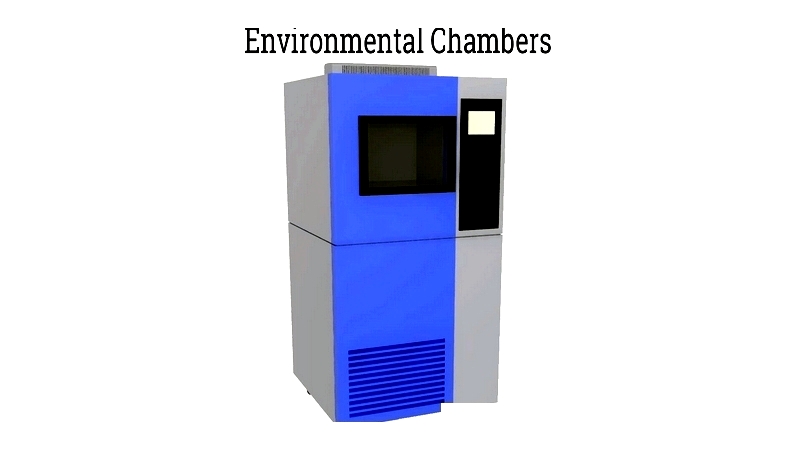Introduction
This article provides an in-depth examination of environmental test chambers.
You will learn about various topics including:
- What is an environmental test chamber?
- How environmental test chambers work
- Applications of environmental testing chambers
- Different types of environmental testing chambers
- Key components of an environmental test chamber
- Benefits of using environmental testing chambers

What is an Environmental Test Chamber?
An environmental test chamber is an advanced device that simulates various atmospheric conditions to evaluate how components and assemblies perform, function, and withstand different environments. This equipment offers valuable data on product responses under both normal and extreme conditions. Researchers utilize these chambers to recreate scenarios like high humidity, temperature variations, and pressure changes to thoroughly analyze product behavior.
Environmental testing helps companies verify product quality and reliability. By subjecting samples to various tests, manufacturers can assess performance and durability. The results reveal potential problems such as corrosion, rust formation, or emissions.
Data from environmental test chambers assists in:
- Identifying product strengths and weaknesses
- Estimating product lifespan
- evaluating product behavior under controlled conditions
- Choosing suitable materials for manufacturing based on performance

How Does an Environmental Test Chamber Work?
Environmental test chambers, also called climatic test chambers or environmental simulation chambers, are essential laboratory instruments that recreate diverse environmental conditions for product testing, reliability assessment, and quality control. These temperature and humidity test chambers use sophisticated heating and refrigeration systems to simulate extreme temperatures. For humidity regulation, built-in steam generators increase moisture levels while dehumidifiers and air dryers reduce humidity to meet precise specifications. This control over temperature, humidity, and environmental factors enables thorough performance testing for electronics, automotive parts, aerospace components, and medical devices.
Specialized tests like corrosion resistance evaluation are conducted by introducing salt water spray environments. Salt spray conditions are created by atomizing a saline solution and distributing it into the chamber using compressed air, following ASTM B117 or similar standards. This process simulates prolonged exposure to corrosive elements, allowing manufacturers to test coating durability, metal resistance, and product longevity under accelerated aging conditions.
Different types of environmental testing chambers are designed for specific testing requirements. Steady-state testing chambers maintain consistent conditions, ensuring stable temperature and humidity levels throughout extended test periods. These chambers are crucial for baseline reliability testing and validation, delivering accurate and repeatable results.
For applications requiring evaluation under changing conditions, thermal cycling chambers (or temperature cycling test chambers) alternate between preset temperature levels. This process helps detect component vulnerabilities or potential failures caused by rapid temperature changes. Automated thermal cycling minimizes human error in environmental control and ensures compliance with strict industry standards like IEC, MIL-STD, and ASTM. The ability to adjust ramp rates, dwell times, and cycle durations allows engineers to simulate real-world usage patterns for critical components and systems.
When selecting an environmental test chamber, its operational range is a key consideration. Modern chambers typically support temperatures from -80°C (-112°F) to +300°C (+672°F), with high temperature uniformity and stability. Many models also offer wide humidity control (from 10% RH to over 98% RH), enabling simulations that match various geographic and seasonal conditions. Features like programmable controllers, data logging, and remote monitoring enhance testing flexibility and accuracy. Choosing the right chamber—based on size, performance specifications, and compliance with test standards—ensures optimal product reliability, regulatory approval, and consumer safety.
In summary, environmental test chambers are vital for product development, material analysis, and compliance testing by replicating the diverse conditions products may face during their lifecycle. Investing in appropriate environmental simulation equipment enhances product quality, reduces field failure risks, and builds customer confidence through proven durability and performance.
Applications of Environmental Test Chambers
Environmental test chambers are indispensable laboratory tools used in multiple industries—including automotive, electronics, medical devices, pharmaceuticals, construction, and cosmetics—for simulating controlled environmental conditions. These chambers play a crucial role in product testing, quality assurance, research, and development. In regulated sectors like pharmaceuticals and food, environmental test chambers help ensure compliance with FDA regulations and industry standards through reliable environmental simulation and stress testing.
In microbiology and biological research, environmental test chambers provide precise conditions for studying the effects of temperature, humidity, light, and other variables on living organisms. These chambers support research on plant growth, insect behavior, microbial development, and cellular responses to environmental stress. By simulating various climatic scenarios—including accelerated aging and humidity cycles—researchers can analyze growth rates, metabolic activity, and physiological changes in organisms. This level of control is essential for agricultural biotechnology, genetic engineering, and life sciences applications.
The aerospace and defense industries rely on environmental test chambers to validate equipment performance under extreme conditions. Thermal vacuum chambers, altitude test chambers, and cryogenic chambers replicate the harsh temperatures, low pressure, and vacuum of space. These tests determine whether aerospace components, satellites, and life-support systems can withstand high altitudes and space conditions. Environmental testing also qualifies avionics, propulsion systems, and other aircraft parts against MIL-STD requirements and NASA standards.
The automotive industry uses environmental test chambers to evaluate materials, components, and electronics under simulated usage conditions. Dynamic chambers can reproduce thermal cycling, UV exposure, humidity, wind, vibration, and impact—mimicking both normal and extreme driving conditions. This testing is vital for verifying automotive reliability, corrosion resistance, paint durability, battery performance, and advanced driver-assistance systems (ADAS) in various environments. Environmental simulation during product development reduces warranty claims, ensures safety, and supports compliance with ISO, SAE, and FMVSS standards.
For food and beverage manufacturers, test chambers accelerate storage conditions to study shelf life and packaging performance. Controlled temperature and humidity testing helps identify optimal food safety protocols, packaging solutions, and ingredient stability. Continuous monitoring using test chambers reduces development risks and ensures regulatory compliance. These chambers also evaluate packaging material performance against oxygen intrusion, moisture loss, and temperature changes, optimizing product freshness and durability.
Electronics manufacturers employ environmental test chambers to assess PCB reliability, semiconductor moisture sensitivity, and component thermal cycling. Chambers enable environmental stress screening (ESS), accelerated life testing (HALT), and compliance with standards like IEC 60068 and JEDEC for electronics durability and safety. By identifying potential failures, manufacturers can prevent costly recalls and extend product lifespans.
In conclusion, environmental test chambers provide critical data for regulatory approval, product safety, and quality assurance. Whether for research, certification, or production testing, these chambers are essential for developing robust, market-ready products across numerous industries.




